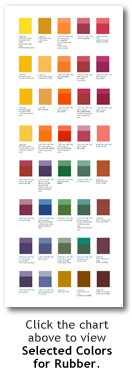Color Chart
 Which form of color do you need?
Which form of color do you need?
To solve our customers' problems in rubber, vinyl, polyethylene, or other
thermoplastics, Akrochem Colors are available in the following forms.
We would be happy to work with you to select the best color and form for
your particular requirement. Click here to request our
Color Chart for Rubber.
DRY POWDERS:
Dry Powder Color Properties
Finely ground, full strength dry colors.
LAKES:
Extensions of the full strength dry colors with inert pigments. These
usually give better dispersion than powders, particularly in soft stocks.
AKROSPERSE® RUBBER COLOR MASTERBATCHES:
Masterbatch Color Properties
Pre-dispersed colors. These give optimum color control and eliminate
dusting completely. Colors are dispersed in the following:
|
|
COLOR PASTES:
Pastes Color Properties
Paste form. Three are used in liquid systems, such as latex, polyesters or plastisols.
Suggestions for Compounding Colored Rubber
Compound to conserve color cost
The color is usually the most expensive ingredient in a compound. It is often sensitive to curing conditions and to other compounding ingredients. Anything which tends to change the shade of the base compound will affect the color shade.
Compound with the correct grade of rubber
Where crude rubber is used, the darker and cheaper grades should be used only in deep shades. Use light colored rubbers for pastel shades. Use non-staining synthetic rubbers.
Compound with non-discoloring accelerators, antioxidants and plasticizers.
Compound for proper cures
Temperatures above 320℉ are risky with many organic colors, particularly in light shades. Select colors carefully for higher temperatures. See the properties sheet for Akrochem Selected Rubber Colors.
General Notes:
- Cool stocks before stacking to prevent change in shade.
- Do not use dark colored fillers.
- Titanium Dioxide and Zinc Oxide improve brightness in pastel shades.
- Reduce the use of Titanium Dioxide to a minimum for deep shades.
- Excessive use of fatty acid or softeners may cause mold staining, color streaking or
blooming of the color.
Our color laboratory is at your service for developing colored products and color-matching. Call on our extensive experience in coloring rubber, vinyl, polyethylene, or thermoplastics when you next have a color problem.



